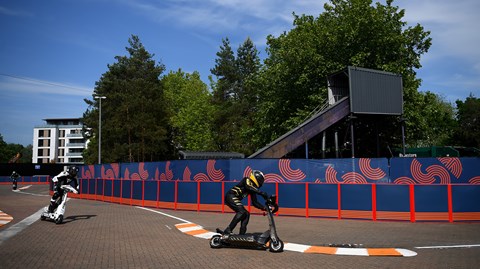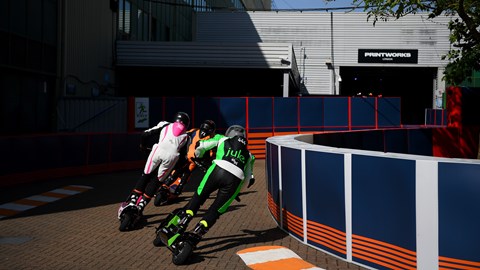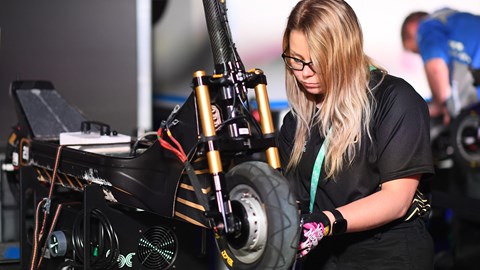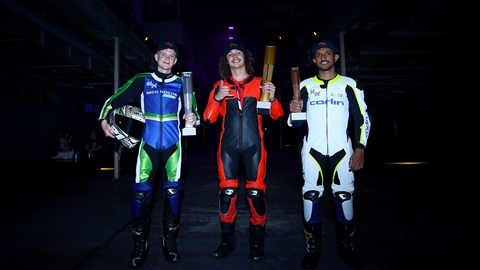ESkootr, the electric scooter championship has arrived. The brainchild of Alex Wurz, Luca Di Grassi as well as a team of investors, the new sport has been constructed with a laser-guided aim to fill a new niche in mobility and sport. Cheap to run, cheap to visit and designed to be highly inclusive and accessible, it ticked all the business case boxes when we went to the launch at the Shard.
The all-new electric sport kicked off in London last weekend, with two days of racing at the London-based Printworks venue. 30 competitors took part in two days of racing, with Swiss racer Matis Neyroud coming out on top. But what was it like in reality? CAR went to the inaugural event to find out: here’s our impressions from the ground

Printworks is a great venue
The Printworks is best known as a music venue, but such is the nature of eSC that it also made for a good racing venue, too. As an old printworks come nightclub it’s full of high ceilings, industrial fittings and finishes, spotlights and a substantial soundsystem – everything you need to set out your stall as the next accessible all-electric series.
There’s lots to like about the track
Formula E and WEC driver Lucas di Grassi is one of the co-founders of eSC, so it’s natural to wonder how much the first eSC venue has been tempted by his all-electric experience. For example, the Printworks course featured an interesting mixture of indoor and outdoor racing – something previously seen at the Formula E London e-prix. There it gave a unique take on the racing; offering stunning views indoors but also adding versatility for punters. Think of something between Robot Wars and Formula E and you’re pretty much there.
The scooters could look faster
Much like Formula E, eSC seems to suffer from a compound of slow equipment and slow tracks. In order to make things look faster, the track is tight and twisty in parts – but this has the overall effect of making some of the racing look rather unwieldy. Some competitors even mentioned the scooters have more pace, and the track was simply too narrow to use it.
It was also interesting to note that the footage of the event seemed to use blur that made everything look faster. Whether that was intentional or not is unclear.

It feels a bit haphazard
While eSC looked visually impressive for the most part, there were parts of the course that looked a little haphazard – as if the event had been quickly set up as Apprentice-task. While the interior parts of the course were slick and bathed in lighting, bits of the outdoor course looked very temporary. Perhaps this’ll change as the sport attracts more sponsors.
The technique is mesmerising
Watch single laps alone, and eSC is strangely compelling. Sitting somewhere between figure skating and motorbike racing, it’s all about lean angle and corner exits – and in lots of places the track really emphasises this. What’s more, there are currently several different styles on show; some use legs in line, some squat down, and others approach corners with a Valentino Rossi-esque leg-dangling before the apex.
Overtakes on the brakes look worrying
Some of the racing, however, feels a little clumsy – at least in its current form. The scooters seem unwieldy in close-quarters racing, while many of the braking overtakes look wobbly at best and chaotic at worst. That could be down to the track surface, the weight of the scooters or bad technique – we’ll find out after more rounds.
It’s more inclusive
Many racing series have tried to expand the demographic of their audience, but eSC seemed to have done a great job – if the first event is anything to go by. The first round of eSC was able to pull in a broad range of people; whether it’s down to ticket prices, the competitors racing, the location or a mixture of all of the above is unknown – but other racing series ought to take note.
It’s very accessible

While my media pass had a few benefits, it didn’t significantly elevate me beyond the paying guests. That meant everyone at the event was able to wander around the paddock and watch the drivers prepare, and the engineers set up the scooters. It’s this sort of accessibility that’ll endear a sport with fans.
It’s a promising start
Lucas Di Grassi is a very intelligent businessman as well as a quick racing driver – and it’s even more obvious after the first eSC event. Everything in the new sport feels deliberate and part of a highly efficient business model; from the drill-based eSC theme tune, the artist line-up afterwards, to the low set-up costs and the music played throughout the races. In that sense it’s hard to view eSC without a cynical overtone.

However, it’s fair to say any motorsport set up in 2022 needs to earn its keep. F1 has monetized itself in almost every aspect, while Formula E partly exists as an entertaining marketing exercise. In the same way, eSC seems to be the right sport, at the right time, for the right price – and it’s targeting an untapped audience too. Sure, it’s tailor made, but that effort should be commended – even if the racing and the tracks need a bit of work.